#UNESCO World Cultural Centre
Explore tagged Tumblr posts
Text

Bison calves stand in Saskatchewan’s Wanuskewin Heritage Park, the first to be born in the the Archaeological Site and Cultural Centre in more than 150 years. Photo By WanuskewinHeritage Park
How Canadian Bison Have Been Brought Back From The Brink In Saskatchewan
In Saskatchewan’s Wanuskewin Heritage Park, bison are a vital piece of the indigenous cultural history and have been brought back from the brink to help rewild fragile grasslands.
— By Karen Gardiner | Published June 3, 2023 | July 29th, 2025
Dr. Ernie Walker has heard enough tired takes on Saskatchewan’s flat landscape. “A lot of people refer to the prairies as big and empty or useless,” he says, indignant, as he leads me around Wanuskewin Heritage Park, an archaeological site and cultural centre 15 minutes from the Saskatchewan city of Saskatoon. “That’s not it. What’s significant about the prairies is that it’s subtle.”
Standing under a big blue sky, amid dry rolling grassland that stretches uninterrupted all the way to the horizon, I think I understand the misconception: lacking mountains and with sparse trees, this isn’t exactly the type of landscape that wallops you with its dramatic features. But if there’s anyone who can convincingly argue for the value of this place, it’s Walker.
The park’s founder and chief archeologist, Walker has spent four decades with his hands in Wanuskewin’s dirt, turning up artefacts — including stone and bone tools, amulets and even gaming pieces — that have whispered to him stories of this land’s significance. Working here as a ranch hand in the early 1980s, he convinced his boss that the land had great archaeological importance. That slowly set in motion the park’s establishment, which involved a rare-for-the-time collaboration between Indigenous and non-Indigenous people.
“When visitors look at the landscape, I’m always interested in what they’re actually seeing,” Walker continues. “They need to know the story behind this place.” The story here is of 6,000 years of almost uninterrupted human occupation. That narrative was drummed into the land by millions of bison hooves until the animals met a violent end. But now, the bison are back and they’re writing a new chapter.
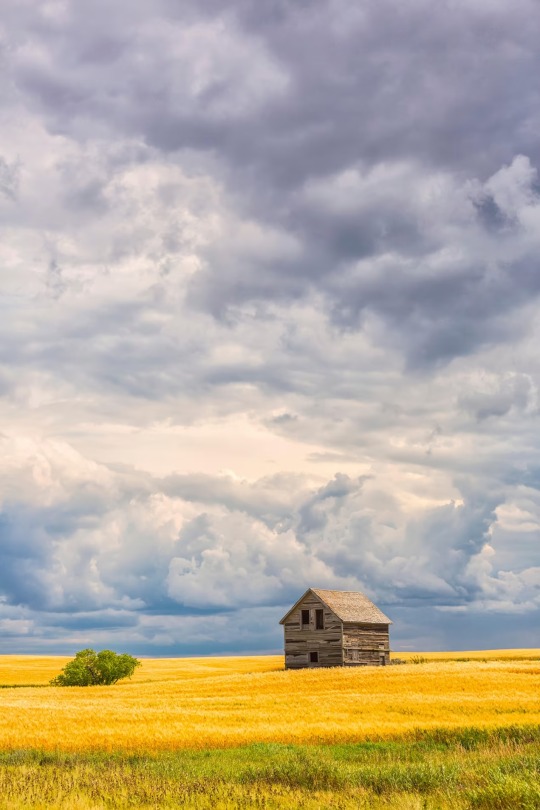
An abandoned building stands along the roads of rural Saskatchewan. Photo By Design Pics Inc, Alamy
A Place of Sanctuary
In the Nēhiyawēwin (Plains Cree) language, ‘Wanuskewin’ roughly translates as ‘sanctuary’. Lying at the fertile confluence of the South Saskatchewan River and Opimihaw Creek, it was a gathering place for the people of the Northern Plains — the Blackfoot, Cree, Ojibwa, Assiniboine, Nakota and Dakota — who all followed bison herds and found sustenance and shelter here. Before European settlement, this land was home to vast numbers of bison (also known as buffalo) and the multitudes of species they supported, from the insects that thrived in the bison’s manure and the birds that fed on those insects to the humans that were dependent on the bison’s meat and skin.
But then came catastrophe. Bison were deliberately slaughtered to near extinction, a tactic used by settlers to starve Indigenous people into submission. “Around 400 years ago, there were 26 to 30 million bison on the Great Plains in North America,” Walker says. “By the 1890s, there were just 1,200.”
With the bison and their way of life gone, Plains people were left with little choice but to sign Treaty Six, an 1876 agreement with the British Crown that opened up the land for European settlement and promised one square mile of land to every Indigenous family of five. They were then corralled onto reserves.
“What if I were to come to all of your houses, empty your fridges and say you guys have to move to the s****y part of town?” Wearing a fringed buckskin waistcoat adorned with beaded flowers, Jordan Daniels, a member of the Mistawasis Nêhiyawak (Cree) Nation, raises his voice above the prairie wind to ensure we understand the depth of his ancestors’ loss. I’ve left Walker for now and joined a small group along Wanuskewin’s bison viewing trail where we’ll see and learn about Wanuskewin’s reestablished herd.
“The bison were a central part of our existence,” Daniels explains. “We made our teepees out of them. They were a main food source. Everything we needed for sustenance came from these animals.” There was also an emotional connection. Many Indigenous people consider bison kin, and the animal is ubiquitous in Indigenous stories and art. “They played a central role in our beliefs and in our way of seeing the world around us,” explains Daniels.
Bringing back the bison to Wanuskewin was always the park’s founders’ dream. In 2019, the animals finally came home. Six calves from Saskatchewan’s Grasslands National Park established the herd, followed by an additional five animals from the United States with ancestral ties to Yellowstone National Park. The herd, which has grown to 12, is now helping to restore native grasses. North America’s grasslands are one of the most endangered biomes in the world and bison, a keystone species, can help restore balance between animals, land and humans.
While grazing, Daniels explains, bison’s hooves aerate soil and help to disperse seeds, and by wallowing (rolling around), they create depressions that fill with rainwater and stimulate plant growth and provide habitat for microorganisms, amphibians and insects. “They’re ecologically unmatched,” he says. “But, I feel, nothing outweighs the cultural factor of having bison back here.”
Daniels’ connection is intensely personal. He explains that his seven-times great grandfather was Chief Mistawasis, the first chief in Saskatchewan to sign on to Treaty Six. Before signing, Daniels says, Mistawasis “had spent his life living how our people have done since time immemorial, out on the plains hunting bison. And today, I’m able to look at animals that are genetically close to the ones that he’d have interacted with. It’s a very impactful and powerful thing.”

Tianna McCabe, a Navajo, Arapaho and Cree powwow dancer, explains the significance of her ornate regalia. Photo By Concepts/KareeDavidsonPhotography.Com
Happy To Be Home
Wanuskewin is about protecting the future as much as preserving the past. I meet with young Indigenous people who demonstrate aspects of their cultures, once suppressed, now thriving. Tianna McCabe, a Navajo, Arapaho and Cree powwow dancer, explains the significance of every fabric and colour of her ornate regalia before hopping her way through an Old Style Fancy Shawl dance, her feet landing with each staccato beat of a drum.
As the day eases into night, I follow a group to the top of a bluff to meet Métis chef Jenni Lessard, who’s prepared our Han Wi (‘moon dinner’ in Dakota language). As well as bison tenderloin, sourced from a nearby farm and seasoned with yarrow and sage, we eat pickled spruce tips and bannock bread with chokecherry syrup. Sipping wild mint and fireweed tea, we gather around a fire, rejoined by Dr Ernie Walker to hear “a miraculous story”.
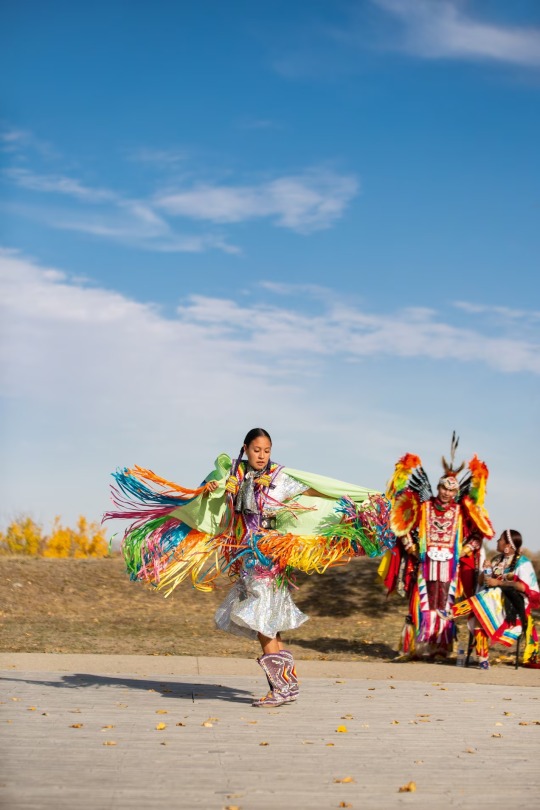
Dezaray Wapass, a Fancy Shawl dancer, performs in Wanuskewin National Park. Photo By Concets/KareeDavidsonPhotography.Com
In August 2020, Walker was visiting the bison herd when he noticed a boulder protruding from a patch of vegetation the animals had worn away. Seeing a groove cut across the top of it and, brushing away the dirt, he spotted more cuts and realised what he was seeing was a petroglyph. The boulder turned out to be a ‘ribstone’, so-called because its engraved motifs represent bison ribs. Three more petroglyphs were later unearthed, as well as the stone knife used to carve them.
What the bison did when they uncovered those petroglyphs was to complete the story of Wanuskewin. “We’d always lamented that, here in the park, we’ve got [archeological sites like] buffalo jumps, teepee rings and North America’s most northerly medicine wheel, but we didn’t have any rock art,” explains Walker.
Wanuskewin is on the tentative list for UNESCO World Heritage designation. The discovery of the petroglyphs, Walker believes, has boosted its chances. He tells me: “The stones complete everything you’d expect to find on the Northern Plains, but you don’t usually find those things within walking distance of each other.”
Dressed in a white Stetson, blue jeans and cowboy boots, Walker retains the appearance of a young ranch hand but, after 40 years of arguing for this place, I sense he’s content to rest a little. “I’ve told this story many times before,” he says. Now, the bison have picked up Wanuskewin’s epic story and it’s time to let them tell it once again.
#Canadian Bison#Saskatchewan#Wanuskewin Heritage Park#Archaeological Site and Cultural Centre#Dr. Ernie Walker#Chief Archeologist#Nēhiyawēwin (Plains Cree) Language#Wanuskewin (Sanctuary)#Blackfoot Cree Ojibwa Assiniboine Nakota and Dakota#Jordan Daniels#Mistawasis Nêhiyawak (Cree) Nation#Indigenous People#Grasslands National Park#Tianna McCabe a Navajo Arapaho and Cree Powwow Dancer 💃#Old Style Fancy Shawl Dance 💃#Métis chef Jenni Lessard#Han Wi (‘Moon Dinner’ in Dakota Language)#Chokecherry Syrup#Petroglyphs#UNESCO World Heritage
12 notes
·
View notes
Text
Historic Centre of Tallinn

Embark with me on a virtual journey to the UNESCO World Heritage site—the Historic Centre of Tallinn in Estonia. Join the adventure as we explore the cobblestone streets and medieval charm of this enchanting city, where history whispers through the walls of centuries-old buildings.
In 1997, the Historic Centre of Tallinn received UNESCO World Heritage status, acknowledging its outstanding universal value and the preservation of a unique medieval urban landscape that continues to captivate the world.
Marvel at the silhouette of St. Olaf's Church, once the tallest building in the world. Climb to the top for panoramic views of the city and the Baltic Sea, and feel the echoes of centuries past in this architectural masterpiece.
Ascend Toompea Hill, the seat of power and the backdrop for legends that have echoed through the ages. Explore the iconic Toompea Castle and Alexander Nevsky Cathedral, where history and architecture intertwine in a dance of grandeur.

Step into the heart of Tallinn's Old Town, a medieval wonderland where each cobblestone tells a story of the past. The city's historic centre is a treasure trove of architectural marvels, blending Gothic, Baroque, and Renaissance influences into a harmonious tapestry.
Wander through Raekoja Plats, Tallinn's Town Hall Square, frozen in time and surrounded by vibrant buildings that house cozy cafes and artisan shops. Immerse yourself in the lively atmosphere that has enchanted residents and visitors alike for centuries.
Discover the legacy of the Hanseatic League in Tallinn, where the city's prosperity was woven into the fabric of medieval trade routes. The merchants' houses lining the streets bear witness to a time when Tallinn thrived as a key player in Northern Europe's commerce.
Embark on a virtual exploration of Tallinn's Historic Centre through online exhibits, 360-degree tours, and digital reconstructions. Roam the digital lanes and immerse yourself in the captivating history and timeless beauty of this UNESCO World Heritage site.
In conclusion, Tallinn invites you to get lost in its narrow lanes, unraveling the tales of knights, merchants, and everyday life etched into its stone streets. When you're ready for a digital escapade through a UNESCO World Heritage site that feels like a fairytale come to life, Tallinn awaits with open arms. 🏰✨🇪🇪
#historic#centre#town#city#tallinn#estonia#europe#travel#unesco#world heritage#site#baltic#sea#medieval#culture#architecture
1 note
·
View note
Text
Florence, Italy: Florence is the capital city of the Italian region of Tuscany. It is also the most populated city in Tuscany. Florence was a centre of medieval European trade and finance and one of the wealthiest cities of that era. The city attracts millions of tourists each year, and UNESCO declared the Historic Centre of Florence a World Heritage Site in 1982. The city is noted for its culture, Renaissance art and architecture and monuments. Wikipedia
545 notes
·
View notes
Photo

Meroë
Meroe was a wealthy metropolis of the ancient kingdom of Kush in what is today the Republic of Sudan. It was the later capital of the Kingdom of Kush (c. 1069 BCE to c. 350 CE) after the earlier capital of Napata was sacked c. 590 BCE. Prior to that date, Meroe had been an important administrative centre.
The city was located at the crossroads of major trade routes and flourished from c. 750 BCE to 350 CE. Meroe is listed by UNESCO as a World Heritage Site. As no one yet has been able to decipher the Meroitic script, very little can be said for certain on how Meroe grew to become the wondrous city written about by Herodotus circa 430 BCE, but it is known that the city was so famous for its wealth in ancient times that Cambyses II of the Persian Achaemenid Empire mounted an expedition to capture it. The expedition faltered long before reaching the city owing to the difficult and inhospitable terrain of the desert (and, according to some claims, may never have been mounted at all). Still, the persistence of the story of Cambyses' expedition suggests the great fame of Meroe as a wealthy metropolis.
The city was also known as the Island of Meroe as the waters flowing around it made it appear so. It is referenced in the biblical Book of Genesis (10:6) as Aethiopia, a name applied to the region south of Egypt in antiquity meaning "place of the burnt-faces". Although there is evidence of overgrazing and overuse of the land, which caused considerable problems, Meroe thrived until it was sacked by an Aksumite king c. 330 CE and declined steadily afterwards.
Egyptian Influence & King Ergamenes
While there was a settlement at Meroe as early as 890 BCE (the oldest tomb discovered there, that of 'Lord A', dates from that year), the city flourished at its height between c. 750 BCE and 350 CE. The Kingdom of Kush, founded with its capital at Napata, was ruled by Kushites (called "Nubians" by the Egyptians) who, early on, continued Egyptian practices and customs and, though they were depicted in art as distinctly Kushite, called themselves by Egyptian titles. The historian Marc Van De Mieroop writes:
Meroitic culture shows much Egyptian influence, always mixed with local ideas. Many temples housed cults to Egyptian gods like Amun (called Amani) and Isis, but indigenous deities received royal patronage as well. A very prominent Nubian god was the lion-deity Apedemak, a god of war whose popularity increased substantially in this period. Local gods were often associated with Egyptian ones: in Lower Nubia, Mandulis, for example, was considered to be Horus's son. Hybridity is also visible in the arts and in royal ideology. For example, kings of Meroe were represented in monumental images on temples in Egyptian fashion but with local elements, such as garments, crowns, and weapons. (338).
In time, however, these practices gave way to indigenous customs and the Egyptian hieroglyphs were replaced by a new system of writing known as Meroitic. The break from Egyptian culture is explained by the ancient historian Diodorus Siculus who writes that in the time before the reign of King Ergamenes (295-275 BCE), it had been the custom for the high priests of the Egyptian god Amun at Napata to decide who became king and to set the duration of the king's reign.
As the health of the king was tied to the fertility of the land, the priests had the power to determine if the sitting king was no longer fit to rule. If they deemed him unfit, they would send a message to the king, understood to be from the god Amun himself, advising him that the time of his rule on earth was completed and that he must die. The kings had always obeyed the divine orders and had taken their own lives for the supposed good of the people. However, Diodorus continues:
who had received instruction in Greek philosophy, was the first to disdain this command. With the determination worthy of a king he came with an armed force to the forbidden place where the golden temple of the Aithiopians was situated and slaughtered all the priests, abolished this tradition, and instituted practices at his own discretion.
The archaeologist George A. Reisner, who excavated the cities of Meroe and Napata, has famously questioned Diodorus' account calling it "very dubious" and claiming that the Ergamenes story was a national myth which Diodorus accepted as historical truth. Since there is no ancient evidence contradicting Diodorus, however, and since there was clearly a significant cultural break between Meroe and Egypt with Ergamenes' reign, most scholars today accept the account of Diodorus as either certain or something close to actual events.
Continue reading...
174 notes
·
View notes
Text


Fenghuang County 凤凰县 in Hunan province. Named after the mythological bird Fenghuang (phoenix) it was built in 1704, and has 300 years of history.
Fenghuang has an exceptionally well-preserved ancient town that harbours unique languages, customs, arts as well as many distinctive architectural remains of Ming and Qing styles. The town is placed in a mountain setting, incorporating the natural flow of the river into the city layout.
The ancient town of Fenghuang was added to the UNESCO World Heritage Tentative List in 2008, in the Cultural category.




It was the centre of the unsuccessful Miao Rebellion of 1854-73, which created a Miao (Hmong) diaspora in Southeast Asia during the last two centuries. The city is revered in Miao traditions and funeral rites.
#china#🇨🇳#hunan#hunan province#fenghuang#fenghuang ancient town#historic towns#chinese ancient town#Chinese historic town#chinese heritage#chinese#chinese culture#chinese history#chinese architecture#miao#miao people#miao culture#hmong#hmong people#regional architecture#hmong culture#sino#architecture#people’s republic of china#prc#villages#Chinese villages#ancient village#Chinese ancient village
57 notes
·
View notes
Text
Joker Out x I Feel Slovenia: Location guide
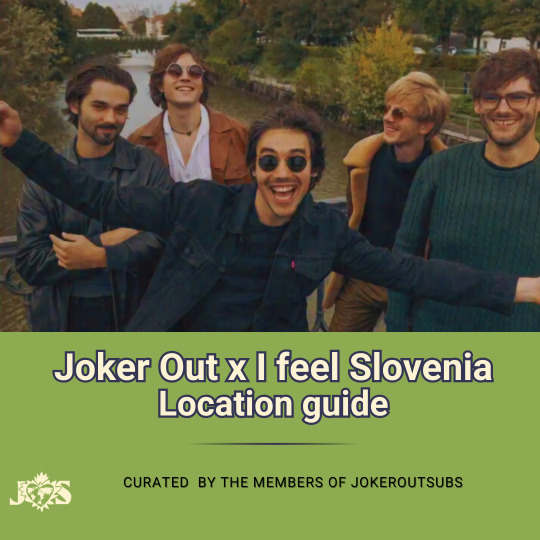
Interested about the locations depicted in the 'I Feel Slovenia' reel? Check them all out here! 👇
Slovenian Philharmonic (Slovenska filharmonija)
It is the white building in the background, right behind Nace. Check out its history here. And the website.

Ljubljana City Museum (Mestni muzej Ljubljana)
Kris is standing in the first room of the City Museum. That room is a display of the people of Ljubljana, both famous and everyday residents. Right now there is a temporary exhibition about the LGBT movement in Ljubljana called Spaces of Movement. Check out their website. Tomaž Mihelič's dress from when Sestre were at Eurovision is in it.


Ljubljana's Central Farmer's Market (Centralna tržnica)
Jure is at Ljubljana's Central Farmer's Market which is a UNESCO World Heritage Site. Check out the Wikipedia page.




Tivoli Park
This is the largest park in Ljubljana. Check out all the beautiful things you can see in this park here. Nace is here with Pino.


Bojan and Kris' street shot.
Bojan is riding past the high school for music and ballet (srednja glasbena in baletna šola), located next to Križanke. The white obelisk you see in Kris' shot is Napoleonov spomenik, a monument built for Napoleon in 1929.


Jan's shots
Jan is visiting the record store SpinVinyl, next to the Ljubljanica river, near the Café Romeo.


Jan is at Kino Šiška, which houses the Centre for Urban Culture and which doubles as a concert hall. Check out its story here.


Tabor's Court (Športno društvo Tabor)
Bojan is playing basketball at Tabor's Court.


From there you can spot also the church from Katrina's music video!

Ring making at the Rog Centre (Center Rog)
The boys are at Rog Centre, which is a production space where you can create things with your hands. There they organise different workshops for children and adults alike! It was controversial upon its opening due to the removal of a previous artistic space, and saw several protests. Check out their info page and their programme page.


#joker out#jokeroutsubs#bojan cvjetićanin#bojan cvjeticanin#jan peteh#nace jordan#kris guštin#kris gustin#jure macek#jure maček#slovenian culture#i feel slovenia#ifeelslovenia#jos: masterpost
82 notes
·
View notes
Text

Tongariro National Park, New Zealand: Tongariro National Park is the oldest national park in New Zealand, located in the central North Island. It has been acknowledged by UNESCO as a World Heritage Site of mixed cultural and natural values. Tongariro National Park was the sixth national park established in the world. The active volcanic mountains Ruapehu, Ngauruhoe, and Tongariro are located in the centre of the park. Wikipedia
100 notes
·
View notes
Text
📍Corfu Greece 🇬🇷
Corfu Town sits on a small peninsula about halfway down the east coast of the island, a site chosen for its natural port and the two peaks that lent themselves to fortress-building. The small mediaeval town that grew up during Angevin rule (1267-1368) was enclosed by thick defensive walls and guarded by two imposing castles that looked out to sea and the Greek mainland. But it was under the Venetians, who stayed for some 400 years (from 1386-1797) that Corfu Town really prospered.
Corfu's significant role in Mediterranean history was pre- destined thanks to its strategic position at the mouth of the Adriatic Sea. Whoever controlled Corfu had a good chance of controlling the most important trade and military routes between east and west and north and south. The Greeks knew this, as did the Romans, the Goths, the Byzantines, the Normans, the Neapolitan Angevins, the Venetians, the French and the British. All came and went, leaving behind them a multi- layered historical and cultural heritage that is still very much in evidence today.
The Venetians brought not only their great commercial know- how but also their architectural prowess and soon Corfu Town became a thriving economic centre with northern-Adriatic flair and impregnable defences (they significantly updated the Old Fortress and built the New Fortress).
Corfu Town was badly bombed by German forces during the Second World War, with almost a quarter of the town being reduced to rubble. Fortunately, much of the mediaeval quarter, known as the Campiello, survived and in 2007 UNESCO awarded Corfu Town the status World Heritage Site.
Καλημέρα Ελλάδα μου!!🇬🇷
26 notes
·
View notes
Text
NURISTAN: SHEDDING LIGHT ON AN INACCESSIBLE CRAFT
HIDDEN IN THE EASTERN MOUNTAINS OF AFGHANISTAN, NURISTANI WOODCARVERS HAVE PERFECTED THEIR CRAFT OVER THE PAST THOUSAND YEARS, ADORNING HOUSES AND MOSQUES WITH CAREFULLY CARVED PATTERNS WHICH MEANINGS HAVE NOW MOSTLY BEEN LOST
Embedded in Afghanistan’s eastern mountains, the region of Kafiristan (“Land of the Infidels”) was long an isolated society. Cut off from the world courtesy of their deep mountain gorges and fierce warriors, their local religion was supplanted by Islam at the end of the 19th century ( renamed ‘Nuristan’, or “Land of Light”), over a millennium after the neighbouring regions. Their unique style of woodcarving, a centuries-old, integral component of their culture, is in dire need of safeguarding lest it be lost forever.
In its efforts to preserve Afghanistan’s intangible cultural heritage, Turquoise Mountain is being supported by the British Council’s Cultural Protection Fund to document and support Afghan crafts such as Nuristani woodcarving. In accordance with the guidelines set out by UNESCO’s 2003 Convention for the Safeguarding of Intangible Cultural Heritage, there is a pressing need to carry out background research on the craft prior to the more detailed inventory, systematically exploring Nuristan’s woodcarving history, symbolism and social meaning in collaboration with the National Archives of Afghanistan, the Afghanistan Centre at Kabul University, and other cultural institutions.
Woodcarving played an integral role in the delineation of Nuristan’s strictly hierarchical, class-based society. The producers of the craft came from the ‘Bari’, a class of people not regarded as members of society. As well as being woodworkers, the ‘Bari’ were more generally labourers, involved in building bridges and water mills, or acting as stone carvers and potters. Deemed to be impure and racially separate from the rest of society, the ‘Bari’ were, prior to the region’s Islamization, treated as slaves. As a result there is no genealogical record of the exceptionally skilled woodcarvers who transmitted the knowledge from master (ustad) to student (shagerd), generation after generation.

In the past Nuristani woodcarving held significant symbolic meaning and essentially acted as a tool of social signaling to identify acts of greatness, specifically hunting and feast-giving. The ‘Atrozhen’, or class of freemen, who made up about 90% of society, were allowed to decorate - or, rather, have the lower class ‘Bari’ decorate - their houses with the symbols. However, within the ‘Atrozhen’ the privilege was tightly controlled. A community council of Big Men effectively held the exclusive privilege of controlling social movement. The social positions and titles that people were given were obtained only upon this council’s approval.
Read More
10 notes
·
View notes
Text
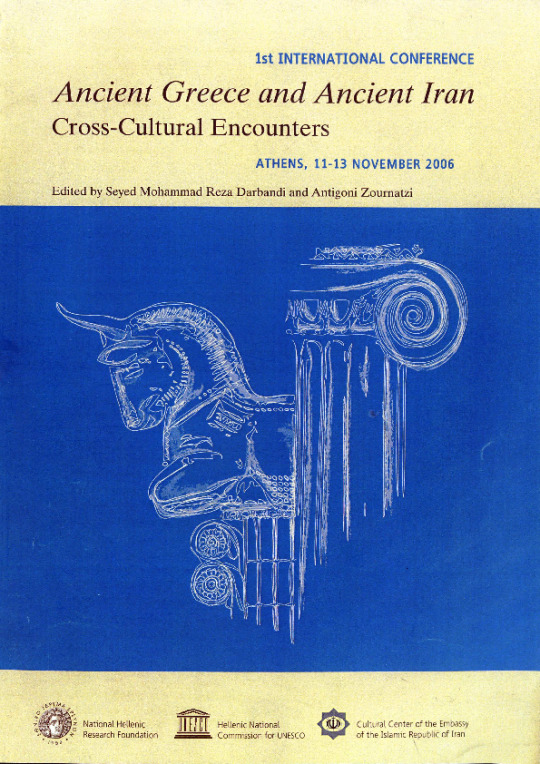
Ancient Greece and Ancient Iran: Cross‐Cultural Encounters 1st INTERNATIONAL CONFERENCE (ATHENS, 11‐13 NOVEMBER 2006) Edited by Seyed Mohammad Reza Darbandi and Antigoni Zournatzi National Hellenic Research Foundation Cultural Center of the Embassy of the Islamic Republic of Iran in Athens Hellenic National Commission for UNESCO Athens, December 2008
Description The extraordinary feats of conquest of Cyrus the Great and Alexander the Great have left a lasting imprint in the annals of world history. Successive Persian and Greek rule over vast stretches of territory from the Indus to the eastern Mediterranean also created an international environment in which people, commodities, technological innovations, as well as intellectual, political, and artistic ideas could circulate across the ancient world unhindered by ethno-cultural and territorial barriers, bringing about cross-fertilization between East and West. These broad patterns of cultural phenomena are illustrated in twenty-four contributions to the first international conference on ancient Greek-Iranian interactions, which was organized as a joint Greek and Iranian initiative.
Contents
Preface (Ekaterini Tzitzikosta)
Conference addresses (Dimitrios A. Kyriakidis, Seyed Taha Hashemi Toghraljerdi, Mir Jalaleddin Kazzazi, Vassos Karageorghis, Miltiades Hatzopoulos, Seyed Mohammad Reza Darbandi, Massoud Azarnoush, David Stronach)
Introduction (Seyed Mohammad Reza Darbandi and Antigoni Zournatzi)
Europe and Asia: Aeschylus’ Persians and Homer’s Iliad (Stephen Tracy)
The death of Masistios and the mourning for his loss (Hdt. 9.20-25.1) (Angeliki Petropoulou)
Magi in Athens in the fifth century BC? (Kyriakos Tsantsanoglou)
Hājīābād and the dialogue of civilizations (Massoud Azarnoush)
Zoroastrianism and Christianity in the Sasanian empire (fourth century AD) (Sara Alinia)
Greco-Persian literary interactions in classical Persian literature (Evangelos Venetis)
Pseudo-Aristotelian politics and theology in universal Islam (Garth Fowden)
The system Artaphernes-Mardonius as an example of imperial nostalgia (Michael N. Weiskopf)
Greeks and Iranians in the Cimmerian Bosporus in the second/first century BC: new epigraphic data from Tanais (Askold I. Ivantchik)
The Seleucids and their Achaemenid predecessors: a Persian inheritance? (Christopher Tuplin)
Managing an empire — teacher and pupil (G. G. Aperghis)
The building program of Cyrus the Great at Pasargadae and the date of the fall of Sardis (David Stronach)
Persia and Greece: the role of cultural interactions in the architecture of Persepolis— Pasargadae (Mohammad Hassan Talebian)
Reading Persepolis in Greek— Part Two: marriage metaphors and unmanly virtues (Margaret C. Root)
The marble of the Penelope from Persepolis and its historical implications (Olga Palagia)
Cultural interconnections in the Achaemenid West: a few reflections on the testimony of the Cypriot archaeological record (Antigoni Zournatzi)
Greek, Anatolian, and Persian iconography in Asia Minor: material sources, method, and perspectives (Yannick Lintz)
Imaging a tomb chamber: the iconographic program of the Tatarlı wall paintings (Lâtife Summerer). Appendix: Tatarli Project: reconstructing a wooden tomb chamber (Alexander von Kienlin)
The Achaemenid lion-griffin on a Macedonian tomb painting and on a Sicyonian mosaic (Stavros A. Paspalas)
Psychotropic plants on Achaemenid style vessels (Despina Ignatiadou)
Achaemenid toreutics in the Greek periphery (Athanasios Sideris)
Achaemenid influences on Rhodian minor arts and crafts (Pavlos Triantafyllidis)
Historical Iranian and Greek relations in retrospect (Mehdi Rahbar)
Persia and Greece: a forgotten history of cultural relations (Shahrokh Razmjou)
The editors Seyed Mohammad Reza Darbandi is General Director of Cultural Offices of the Islamic Republic of Iran for Europe and the Americas. Antigoni Zournatzi is Senior Researcher in the Research Centre for Greek and Roman Antiquity, National Hellenic Research Foundation. Her work focuses on the relations between Achaemenid Persia and the West.
The whole volume can be found as pdf on:
10 notes
·
View notes
Text
Gdansk - Town of Memory and Freedom

There’s something about Gdańsk that tugs at the edges of memory—whether you’ve been there or not. Perched along the Baltic coast, this Polish port city feels like a place where time folds in on itself, where cobbled streets whisper stories of glory, devastation, and bold rebirth. While it’s currently on UNESCO’s tentative list, Gdańsk holds all the soul and weight of a World Heritage Site—just waiting for the world to pause and recognize it.
Walk through the Long Market (Długi Targ) and you’re immediately transported. The colorful facades, gabled rooftops, and ornate details feel almost fairy tale-like, but Gdańsk’s story is anything but soft. Nearly completely destroyed during World War II, what you see today is a masterclass in reconstruction, a painstaking homage to what once was. It’s a city that refused to forget.
The towering Main Town Hall, the majestic Neptune Fountain, and the grandeur of Artus Court stand again—not just as historical monuments, but as symbols of resilience. Gdańsk didn’t just rebuild its buildings—it revived its spirit. This deep commitment to preserving cultural identity while acknowledging trauma is precisely what makes its case for UNESCO recognition so compelling.

But Gdańsk is more than just its postcard-perfect Old Town. It’s also the birthplace of Solidarity, the movement that would help bring down communism in Central Europe. The European Solidarity Centre is one of the most powerful museums I’ve ever stepped into—industrial, raw, and full of hope. It’s here that the spirit of revolution lives on, where you feel how a shipyard and a union helped shift the tides of a continent.
And let’s not forget the water. The Motława River is the city’s lifeblood, lined with dockside cranes, medieval warehouses, and modern cafés. You can watch the sun set over the famous Gdańsk Crane, a 15th-century marvel that once powered trade, or hop a boat out toward the Baltic Sea and feel the chill wind of freedom.
Gdańsk is a city that contains multitudes. Hanseatic trading hub. Wartime victim. Rebirth epicenter. Cradle of freedom. Every brick and every corner feels like a lesson in history, memory, and perseverance. UNESCO or not, Gdańsk already holds a place among the world’s great cities of heritage. It’s a city that doesn’t just tell its story—it invites you to become a part of it.
7 notes
·
View notes
Note
Im not sure if you're a hiking person, but How is hiking/nature in Catalonia? I've been learning the language for the past few months and i am interested in visiting and I really love being out in nature and hiking
Hi! First of all, sorry for the delay in answering, I've been very busy this week and I've left the blog on queue, I'm catching up today.
There's lots of cool places to hike!
Historically, hiking has been very important for keeping alive the culture and language, ever since the 19th century (as a way to getting to know the country and its history, since the population had been denied its own history) and especially until the Franco dictatorship (we have mentioned before how people used going hiking as a way to get away from the police and being able to speak Catalan during the times of illegalization).
There are many hiking associations in Catalonia, you can find them with names like "centre excursionista" or "grup excursionista". I don't know how long you're staying, but if you were to stay for a relatively long time I'm sure you could probably find some hiking association near wherever you stay.
Otherwise, you might also be interested in Wikiloc. It's a website (created by a Catalan) where everyone can upload the routes they like. It's very popular and there's lots of hikes in all areas, and it shows you the route and all the information and what you can see in the way.
There's many places to hike in all around the country. There are many natural parks, with 16 being recognised above the other in (Southern) Catalonia + 1 in Northern Catalonia.
From North to South, by type of landscape:
IN THE PYRENEE MOUNTAINS:
1. Regional Natural Park of the Catalan Pyrenees (Northern Catalonia).
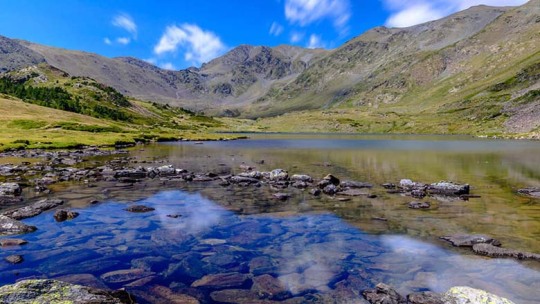
Includes the Canigó mountain, legendary and symbolic mountain for Catalans. If you go there for Sant Joan festivity (June 23rd), you can join the hike to go get the fire on top of the mountain (we explained it in this post).
There's many hikes in the websites Tourisme Canigou and Sud Canigó.
2. Parc Nacional d'Aigüestortes i Estany de Sant Maurici
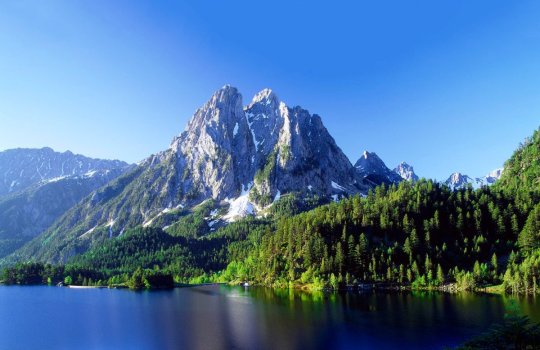
This is another beautiful park in the Pyrenees and the Sant Maurici lake. It's the only natural park in Catalonia that is considered a National Park in the Spanish system.
3. Parc Natural de l'Alt Pirineu (High Pyrenees Natural Park)

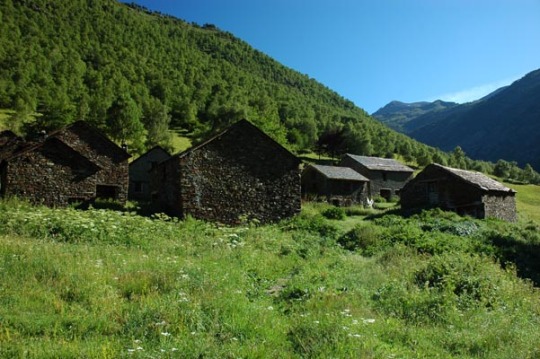
Beautiful mountains and, just like for all the other parks in the Pyrenees, near valleys with beautiful villages of Medieval origin with a heritage of Romanesque churches (the ones in Vall de Boí are recognised as a UNESCO World Heritage Site).
4. Parc Natural de les Capçaleres del Ter i del Freser
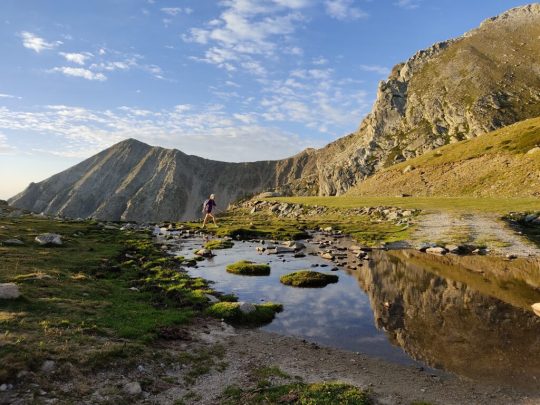
Where the Ter and Freser rivers are born. It includes the Núria Valley (Vall de Núria).
5. Parc Natural del Cadí-Moixeró

Includes the iconic Pedraforca mountain.
ASLEEP VOLCANOES:
6. Parc Natural de la Zona Volcànica de la Garrotxa (Natural Park of the Garrotxa Volcanic Zone)

Includes the Fageda d'en Jordà (Jordà birch tree forest) and cool Medieval towns like Santa Pau, Besalú, Castellfollit de la Roca, els Hostalets d'en Bas, and more.
COASTAL PARKS:
7. Parc Natural del Cap de Creus (Creus Cape Natural Park)


Beautiful coastal area in the Costa Brava, also includes the Medieval monastery Sant Pere de Rodes. In the area there's lots of typically Mediterranean-style towns with white walls, some of them very touristic and some of them less so.
8. Parc Natural del Montgrí, les Illes Medes i el Baix Ter


In the coast of the Costa Brava, it's very beautiful. Also near lots of cute towns of Medieval origin.
9. Parc Natural dels Aiguamolls de l'Empordà (the Empordà Wetlands Natural Park)

And on the opposite end of Catalonia:
10. Parc Natural del Delta de l'Ebre (Ebro Delta Natural Park)
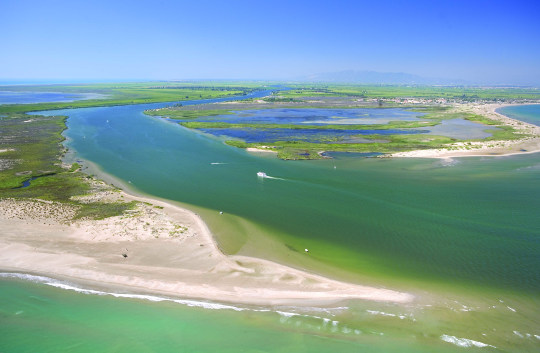
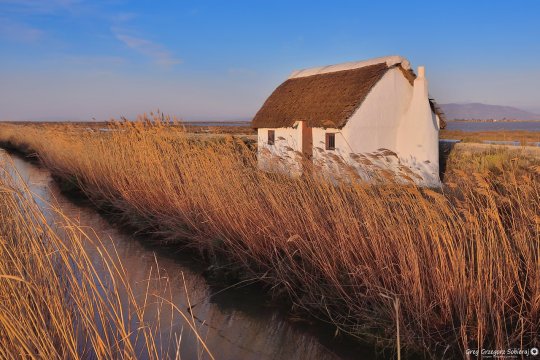
Where the Ebro river reaches the Mediterranean sea. Famous for its rice fields and birdwatching. It's very flat, so it's a good idea to hire a bike and bike through the paths among the rice fields to the sea.
OTHER MOUNTAINS:
11. Parc Natural del Montseny
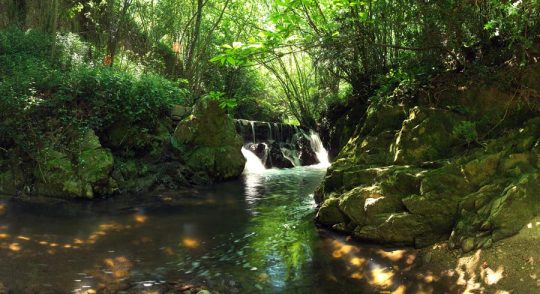

12. Parc Natural de Sant Llorenç del Munt i l'Obac

13. Parc Natural de la Muntanya de Montserrat
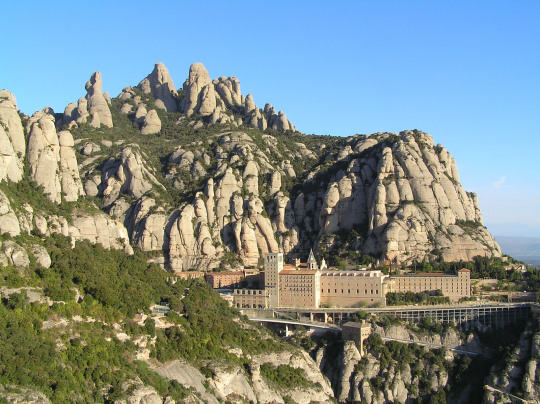
Montserrat is one of the most famous and sacred mountains in Catalonia. It has a very characteristic shape and landscape and is home to a monastery over 1000 years old that guards the Moreneta (black Madonna, patron saint of Catalonia).
14. Parc Natural de Collserola
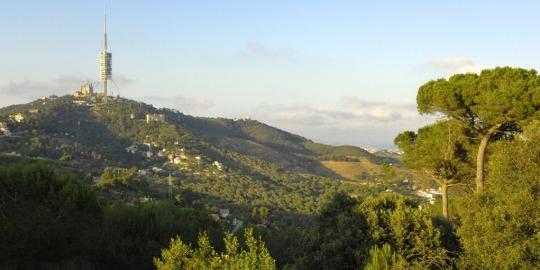
Collserola is the mountain range that overlooks Barcelona city.
15. Parc Natural de la Serra de Montsant
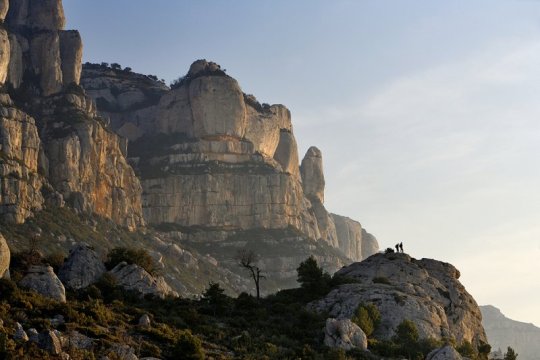
Located in the Priorat wine area (to take into account if you are wine lovers), the Monstant mountain range is located in a very rural area with lots of vineyards cultivated on the mountain slopes and also lots of historical tiny rural chapels, as well as the ruins of the Escaladei Carthusian monastery.
16. Parc Natural dels Ports

Mountains and lots of natural swimming pools you can bathe in.
You'll be able to find hikes in the websites of all of them.
I hope this was useful and that you enjoy your holidays!
#natura#catalunya#natural park#natural parks#hiking#nature#hike#travel#europe#landscape#traveling#explore#wanderlust#adventure#travel photography
42 notes
·
View notes
Photo

Xochicalco
Xochicalco in central Mexico was an important hilltop centre from the 8th century CE and was a rival and successor of Teotihuacán. Architecture at the site is closely connected to that of the Classic Maya, Teotihuacan, and Veracruz, and contact was also established with the Mixtec Oaxaca and Zapotec civilizations. Blending these various cultural elements to create their own idiosyncratic art and architecture, the Xochicalco culture probably went on to influence the later Toltec and all subsequent Mesoamerican civilizations. The site, like many contemporary hilltop centres, was abandoned at the end of the Epiclassic period, around 900 CE. Xochicalco is listed by UNESCO as a World Heritage Site.
Early Settlement
Founded c. 700 CE or even before, Xochicalco, 130 km southwest of Cacaxtla and perched above the Cuernavaca Valley, was built on a hill which was re-shaped by levelling and terracing certain areas to create an acropolis of four concentric terraces. A straight path on the southern side gives access from the valley floor. Although early pottery shares many similarities to that found elsewhere in central Mexico, there seems to have been very little outside contact in later times. Any links to the Maya seem to have been via the coast settlements, and the iconography in many relief carvings at Xochicalco has a strong Mayan and Teotihuacan influence.
Xochicalco was eventually fortified and contained three distinct areas containing regular plazas, sacred precincts, paved causeways, a large pyramidal platform, and an I-shaped ball-court, all oriented along the cardinal points. The large slanted wall ball-court is located in the centre of the site, and it may be the oldest such structure in central Mexico, whilst the western platform contains a sweat-bath consisting of several rooms with benches. Another feature of the site is the presence of caves in the hillsides which were used for storage and, in one case, as an underground observatory. This latter cave has a man-made shaft to the sky, through which, on just two days in the year, the sun shines directly down into the cave.
Continue reading...
36 notes
·
View notes
Text
A Journey to Remember: Exploring Cape Town's Wonders

Introduction:
Cape Town, a city where the mountains meet the sea, is a destination that captivates travellers from around the world with its natural beauty, rich history, and vibrant culture. From the iconic Table Mountain to the scenic Cape Winelands, there's no shortage of attractions and experiences waiting to be discovered in this South African gem. If you're planning a Tour to Cape Town, get ready for the adventure of a lifetime as we dive into the wonders that await you in the Mother City and its surrounding regions.
Table Mountain:
No visit to Cape Town is complete without a trip to Table Mountain, one of the New Seven Wonders of Nature. Whether you choose to hike to the summit or take the rotating cable car, the panoramic views of the city, coastline, and surrounding landscapes are simply breathtaking. Be sure to visit at sunrise or sunset for an unforgettable experience and don't forget your camera to capture the stunning vistas.
Cape Peninsula:
Embark on a journey along the scenic Cape Peninsula, where rugged cliffs, pristine beaches, and charming coastal towns await. Drive along the breathtaking Chapman's Peak Drive, explore the Cape Point Nature Reserve, and visit the adorable African penguins at Boulders Beach. Don't miss the opportunity to take a dip in the refreshing waters of the Atlantic Ocean at one of the peninsula's many beautiful beaches.
Robben Island:
Delve into South Africa's rich history with a visit to Robben Island, a UNESCO World Heritage Site and former political prison. Take a ferry from the V&A Waterfront to the island and tour the prison complex, where Nelson Mandela and other anti-apartheid activists were once incarcerated. Hear firsthand accounts from former political prisoners and gain insight into the country's struggle for freedom and democracy.
Cape Winelands:
Indulge your senses with a day trip to the Cape Winelands, where lush vineyards, historic estates, and award-winning wines await. Explore charming towns such as Stellenbosch, Franschhoek, and Paarl, and sample a variety of wines and gourmet cuisine at some of the region's finest wineries. Don't forget to savour the stunning scenery of rolling hills and mountain ranges that make the Cape Winelands a feast for the eyes as well as the palate.
Kirstenbosch Botanical Gardens:
Escape the hustle and bustle of the city and immerse yourself in the tranquillity of Kirstenbosch National Botanical Garden. Located at the foot of Table Mountain, Kirstenbosch boasts an impressive collection of indigenous plants, including rare and endangered species. Take a stroll along winding paths, discover unique garden sculptures, and enjoy a picnic amidst the breathtaking natural surroundings.
Township Tour:
Gain insight into Cape Town's diverse cultural landscape with a township tour, where you'll have the opportunity to visit vibrant communities such as Langa, Khayelitsha, or Imizamo Yethu. Meet with residents, learn about their traditions and customs, and support local businesses as you explore the streets, markets, and cultural centres of these dynamic neighbourhoods.
Cape Town City Tour:
Discover the rich history, vibrant culture, and iconic landmarks of Cape Town on a city tour. Visit historic sites such as the Company's Garden, Castle of Good Hope, and District Six Museum, and explore the colorful streets of Bo-Kaap with its distinctive Cape Malay architecture. Whether you're wandering through bustling markets or admiring street art in the city's vibrant neighbourhoods, there's always something new and exciting to discover in Cape Town.
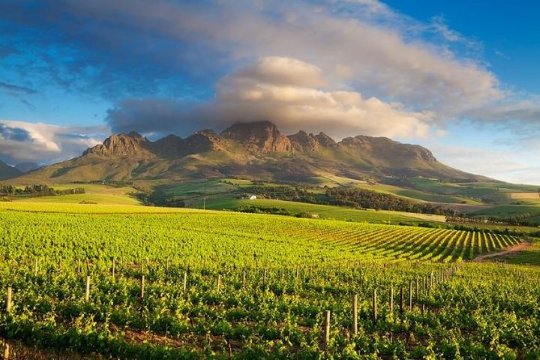
Conclusion:
Cape Town Tours Packages promises an unforgettable journey filled with breathtaking scenery, rich history, and vibrant culture. Whether you're hiking to the summit of Table Mountain, exploring the charming coastal towns of the Cape Peninsula, or indulging in wine tasting in the Cape Winelands, the experiences that await you in the Mother City are sure to leave a lasting impression. So pack your bags, lace up your hiking boots, and get ready for the adventure of a lifetime in Cape Town, South Africa.
3 notes
·
View notes
Text
Saturday 18th May - Day 12
This morning we visited three UNESCO World Heritage Sites, all of which were temples. Having visited a number of countries with very many temples I expected today to become ‘templed out’! However, happily each temple was very different to the others the main downside of today was that it was Saturday and so many local families were also visiting the sites, everywhere was very busy. The month of May is also extremely popular for school trips and we are certainly finding this to be so!
Kinkaku-Ji Temple was our first stop, this site is also known as the Golden Pavilion, this richly decorated temple is beautiful. This site is a zen-Buddhist temple close to Kyoto, it was originally designated as a holiday villa for the shogun Ashikaga Yoshimitzu in 1397. The temple has three levels, the first is the noble peoples style, it is open in style, the second is in the samurai style and the top is in the Buddhist style. The second and third stories are covered in 200,000 gold leaves. The gardens are very beautiful, in the centre and surrounding the temple is the Kyoko-chi pond also called the mirror pond.
Our second visit was to the rock garden of the Ryoanji Temple. Originally the temple was an aristocrats villa which was converted into a Zen temple in 1450. The rock garden is a piece of cultural heritage, the deceptively simple garden consists of 15 rocks spread out on white sand. The rocks are supposed to be arranged so that at no point can you see all 15 rocks at the same time, however it is possible to view them all in one go, if you look carefully!
The final site was the Kiyomizu-Dera Temple. Founded in AD778, the most famous feature of the temple is its wooden veranda, standing 13 metres above the ground. From the veranda there is a good view of the many maple and cherry trees which look stunning in their autumn colours. It is also known as the Pure Water Temple and was founded on the site of the Otowa Waterfall in the wooded hills in the east of Kyoto. Due to the 15 minute uphill walk in the heat we decided not to visit this site but instead to remain around the shops and restaurants. We took the time to enjoy some local food, stick tempura in the following flavours; pumpkin & sweet potato, cuttlefish & cheese … they were interesting! We followed these with a delicious chocolate ice cream .. they do ice cream very well here and then a beer to wash it down.
Back on the bus and we headed for a traditional tea ceremony, something that most of us were looking forward to although with some apprehension about having the matcha tea. The tea house was enormous and was the most beautiful wooden building with very pretty, traditional gardens. Inside the tea house was a large shrine and low tables and chairs were set out for us all along with the tea making equipment, we had, of course removed our shoes before entering the building. We were introduced to our host and another lady who would be the guest for the ceremony, they guided us through the ceremony, which can take up to 3 or 4 hours, there is a strict procedure to be carried out and it takes a number of years to learn how to conduct these ceremonies correctly. Once we had observed and tasted their tea it was time to make our own, which we all did and tried to follow the procedure. Some people enjoyed the taste but I think that the majority found it too bitter for their tastes. However, it was an interesting experience to learn about. We drove on to Gion, the geisha district of Kyoto and walked the streets to see the traditional houses. The temperature today was 29 degrees, so a long and busy day, along with the heat wiped us all out but there would be no time to rest!
Back to the hotel for a very quick turnaround before 10 of us headed out for an optional excursion of a Japanese BBQ. Well, what an evening! 90 minutes in which we could cook, eat and drink as much as we could. We sat on cushions on the floor but there were pits below the table to put your legs into, so more comfortable than just sitting on the floor. Two braziers were already heating up and the table was laden with platters of different cuts of meat and vegetables, there were sauces and cooking utensils so we set to work cooking our supper. Kas was able to order drinks and more food on the app so she was kept busy ordering extras including octopus and scallops, salads more meat, more drinks whilst the rest of us cooked for the whole group. It was a very sociable evening, helped along by a copious supply of plum wine, beer and red wine. Once our time was up we headed for the hotel and some went to the bar for a nightcap.










2 notes
·
View notes
Text
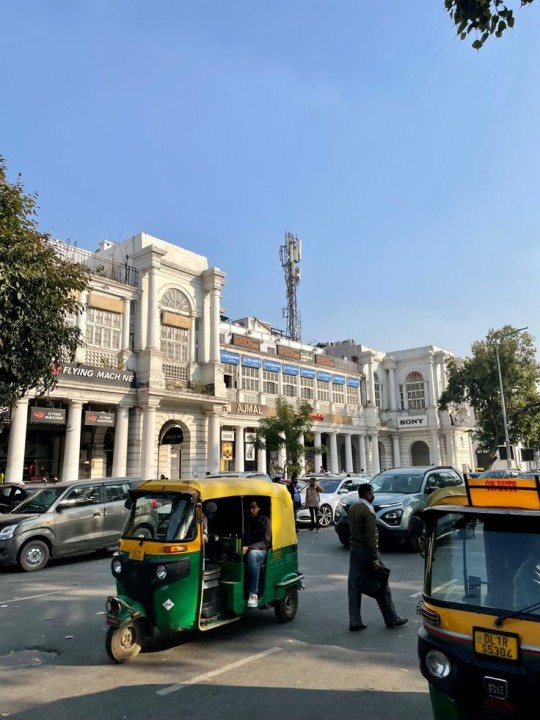
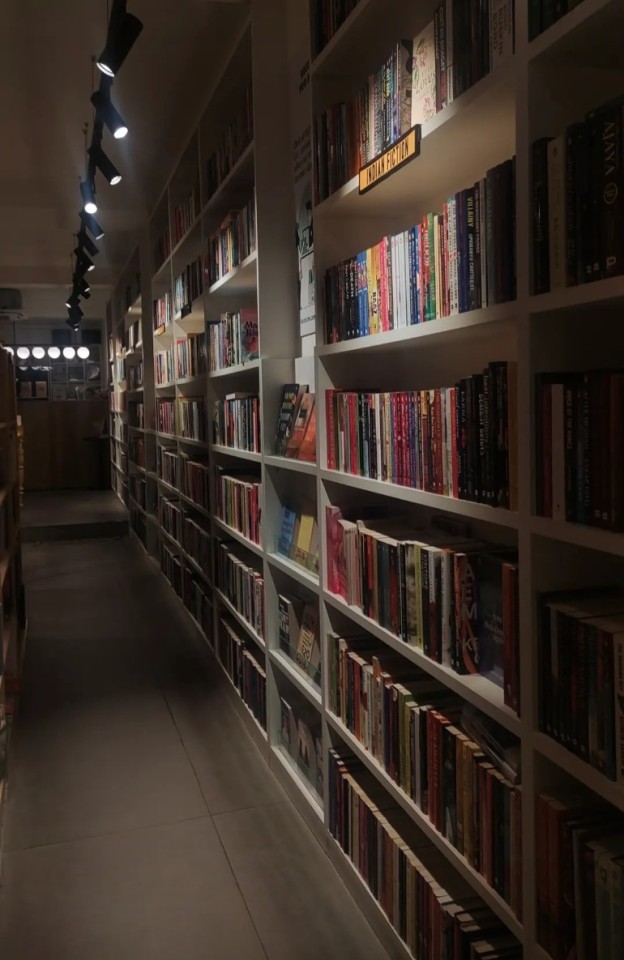
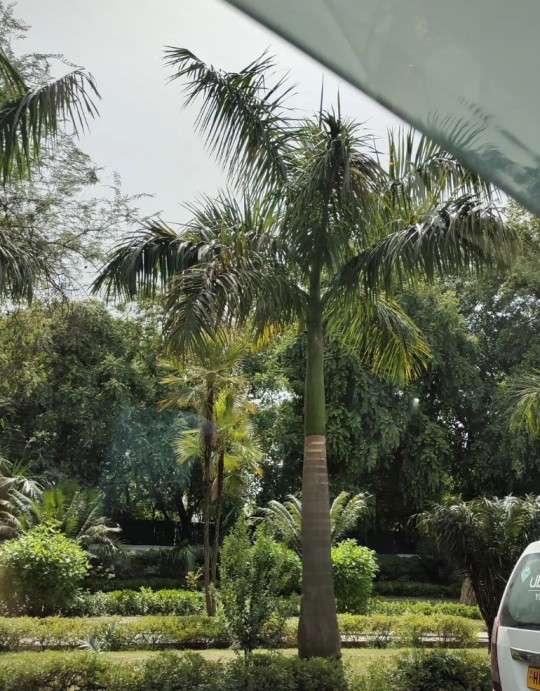
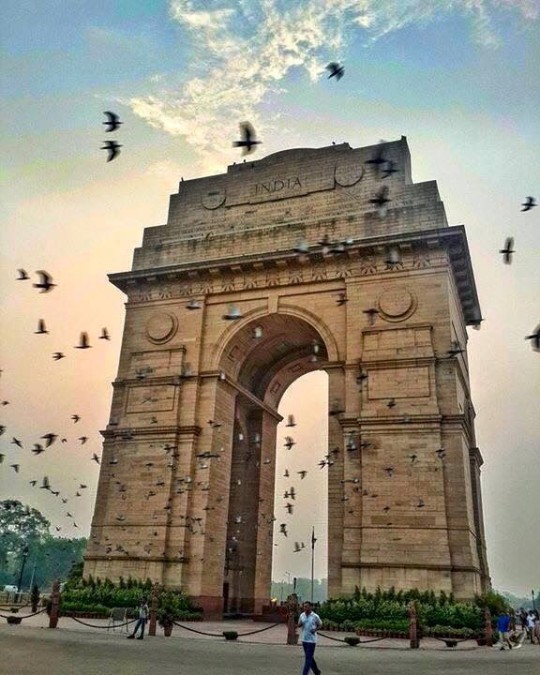
Delhi, the heart and soul of India, is a city that encapsulates the essence of the nation's rich history, cultural diversity, and dynamic spirit. From ancient monuments to bustling markets and modern skyscrapers, Delhi is a vibrant tapestry of old and new, tradition and innovation.
At the heart of Delhi lies its historic monuments, such as the majestic Red Fort, a UNESCO World Heritage Site, and the iconic Qutub Minar, towering over the cityscape as a symbol of ancient glory. The streets of Old Delhi, with their narrow lanes and bustling bazaars, offer a glimpse into the city's Mughal past, while the grand boulevards of New Delhi, designed by British architect Edwin Lutyens, showcase colonial-era architecture and modern urban planning.
Delhi's cultural fabric is woven with threads of diversity, reflected in its cuisine, festivals, and vibrant arts scene. From savoring mouth-watering street food in Chandni Chowk to attending cultural events at the India Habitat Centre, Delhi offers a kaleidoscope of experiences that celebrate the richness of Indian heritage and creativity.
As India's political and economic hub, Delhi is also a melting pot of ideas and aspirations, attracting people from across the country and around the globe. Its bustling markets, thriving industries, and world-class institutions make it a dynamic center of commerce, innovation, and opportunity.
In essence, Delhi is more than just a city; it's a living mosaic of past and present, tradition and progress, where every street corner tells a story and every visit is an adventure waiting to unfold.
3 notes
·
View notes